10 Blended Training Best Practices

In just a few years, we’ve seen numerous organizations shift to blended training due to the pandemic. Blended training uses a blended learning approach to bring the best of both worlds — online and traditional face to face training. This allows for more flexibility and accessibility and improves the learning experience wherein the strengths of both learning methods are maximized.
While blended learning isn’t necessarily new, this hybrid learning environment can be tricky to navigate, especially for those who are only used to classroom training. Additionally, the way we learn has evolved so we have to make sure that we use methods and tools suited to our learners when designing a training program. To help you with this, we’ve gathered 10 blended training best practices that you can integrate into your blended training program.
Sign up for Free and Start Using the Best Blended Training Platform
1. Adopt microlearning
Shifting to microlearning is a meaningful way to deliver training content to your learners in line with traditional face-to-face training. With this approach, information is broken down into manageable chunks and delivered in short bursts, which makes it highly effective as opposed to reading a whole bunch of text on PDF files and PowerPoint decks. Microlearning also uses many interactive and engaging elements that can pique the interest of learners, such as animations, quizzes, simulations, and games. As we now live in a world where many distractions are competing for our time and attention, microlearning helps sustain a learner’s full attention thanks to its short but focused format. Additionally, it turns complex and overwhelming topics into bite-sized lessons that are easier to absorb and understand. This also gives learners a sense of accomplishment and progress as they complete their goals in a little amount of time which can encourage self-learning.
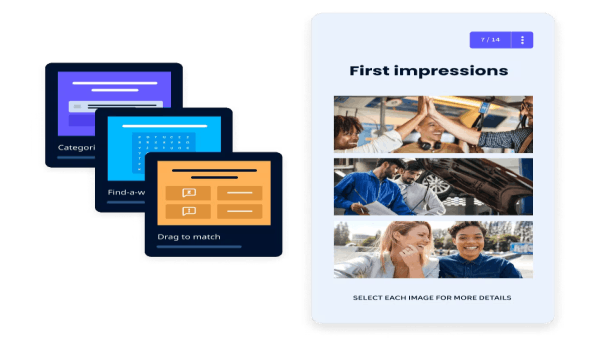
SC Training (formerly EdApp) is an award-winning learning management system that champions microlearning to enhance the learning experience. With SC Training (formerly EdApp), learners can access bite-sized courses from its vast course library on any device whenever they have a few minutes to spare – whether that’s on their commute, in between meetings, or on a break. For teams or individuals who don’t have consistent access to WiFi, SC Training (formerly EdApp) also has an offline mode where learners can download their courses whenever they have internet access and automatically sync their results when they’re back in range.
2. Reinforce learning with spaced repetition
Spaced repetition, or distributed practice, is a highly effective learning technique that increases knowledge retention. You can think of it as a more sophisticated form of flashcards through the act of repeatedly returning a difficult card to the stack so you can see it many times and eventually remember it. With spaced repetition, lessons are retaken at increasing intervals until knowledge is transferred from short term to long-term memory. Studies show that it’s more effective compared to lengthy, one-off unmemorable courses, which only deliver temporary gains and don’t do much in beating the forgetting curve.
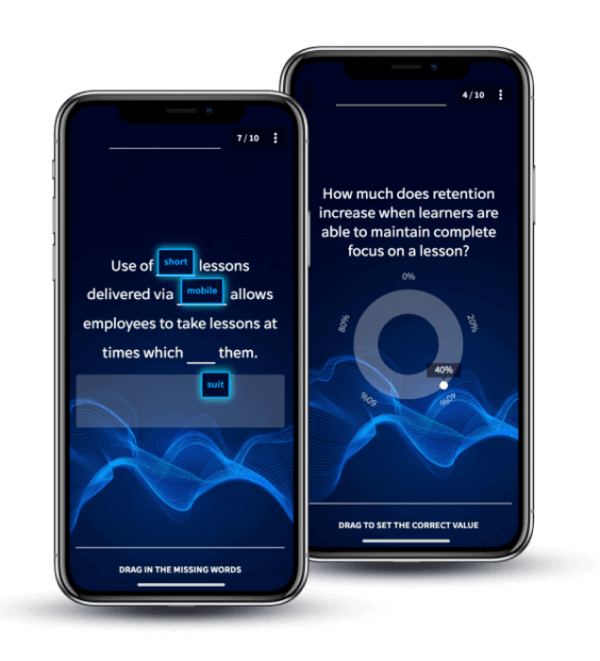
To effectively implement spaced repetition, you’ll need an algorithm-based tool to automate and deliver content to your learners. Housed in SC Training (formerly EdApp)’s LMS is Brain Boost, which automatically creates dynamic lessons based on core, previously learned content. Using the SM-2 algorithm, Brain Boost asks different questions to establish what a learner remembers and what they don’t. The more they get right, the less frequently they’ll need to be tested.
3. Harness the power of collaborative learning
Collaborative learning is perfect for blended training as learners get to interact with like-minded individuals to brainstorm, share ideas, and solve problems, while also improving their social and communication skills. It directly involves them in the learning process, which can make them more interested in the training material. Also, collaborative learning creates a support system both in and out of the classroom, where learners can reach out to each other whenever they need help or guidance.
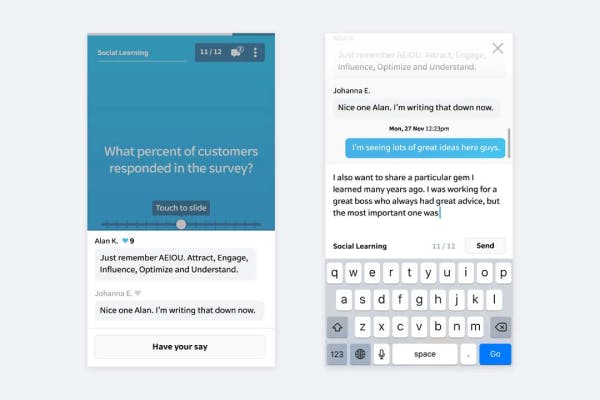
SC Training (formerly EdApp)’s Social Learning feature allows learners to discuss their coursework together and learn from each other. With Social Learning, you can allow learners to add comments, share ideas, and initiate conversations in slides within your lessons. So they won’t miss out on a learning opportunity, they’ll also receive push notifications for every new engagement and can also ‘like’ each other’s comments borrowing from familiar social media elements.
4. Flip your classroom
The flipped classroom is a popular blended training practice where learners are provided with the learning material ahead of time before it’s discussed in the training proper. This is opposite to the traditional norm where lectures first happen before an assignment or supplementary reading materials are given. A flipped classroom setting gives learners more autonomy and allows learning to happen at their own pace. What’s also great about this practice is that it cultivates engagement and discussions since learners already have an understanding of the topic at hand. They can then use the classroom time to extend learning since they’ll have the opportunity to confirm what they’ve learned, ask questions, and make clarifications.

Much of a flipped classroom’s success can be attributed to the quality of the learning material and its appeal to learners. Deploying microlearning courses is an effective way of providing engaging quality training content to learners at home. With SC Training (formerly EdApp)’s drag-and-drop authoring tool and free template library, creating interactive courses can be done in just a few minutes without any technical background. Also, you don’t need to be a graphic designer just to build visually aesthetic lessons. With its Canva integration, you can add and create beautiful graphics, text, custom imagery, animation, and video, all within SC Training (formerly EdApp)’s authoring tool. In addition, if you already have existing Powerpoint training, you can convert them into beautiful microlessons with a click of a button.
5. Take advantage of mobile learning
Smartphones have revolutionized the way we acquire and consume information as learning can now take place in just a few taps with a reliable internet connection. With almost everyone spending long amounts of time on their smartphones, it just makes sense to use it for blended training. Mobile learning, or mLearning, utilizes smartphone technology to make training accessible across multiple devices. This makes learning accessible anytime and learning materials can be revisited as often as needed. It’s perfect for busy and time-poor employees who don’t have time to go through their training during work hours.

SC Training (formerly EdApp) is the perfect mobile LMS to use for mobile learning as any content is perfectly formatted to run seamlessly on both iOS and Android devices. Microlessons are downloaded straight to learners’ smartphones so they learn at their convenience. You can also send them push notifications to inform them of new lessons, deadlines, and reminders so they never miss out on important updates.
6. Utilize video learning
According to Google, millennials are 2.7x more likely to prefer watching a YouTube video compared to reading a book. In addition to their entertainment value, videos are effective for learning as they help provide more context by utilizing a multimodal approach. Aside from providing immersive learning experiences, videos help simplify complex concepts and can fit in more topics in a shorter amount of time. Videos are also easily accessible by learners and can be rewinded, paused, forwarded, and rewatched as needed, which is perfect for learning in a blended environment. The effectiveness of video learning can be seen in action in the Top 10 Employee Training Videos & Microlearning Courses.
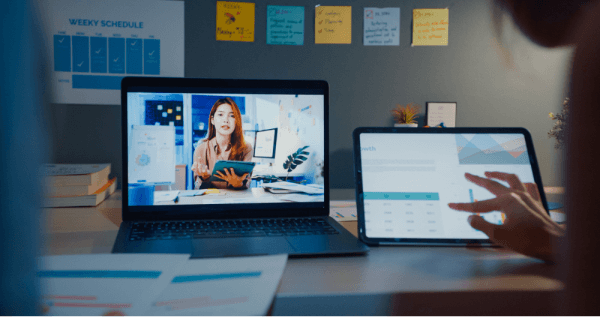
With SC Training (formerly EdApp), you can easily add videos you create to your lessons or embed videos hosted on YouTube or Vimeo using content templates. Aside from pre-recorded videos, you can also set up a virtual classroom and enable video meetings that are directly linked to a course. You can use your preferred third-party video conferencing platforms, such as Zoom and Microsoft Teams.
7. Encourage participation through forums
Many learning theories suggest that learning is a social process and that interactions among learners can significantly boost learning outcomes. In a blended training environment, discussion forums can increase the learners’ involvement with their learning materials and spur a dynamic exchange among peers. It extends learning beyond the classroom as everyone can pitch in and gain insight from one another anytime. It also gives trainers the ability to lead the discussion and provide real-time feedback.
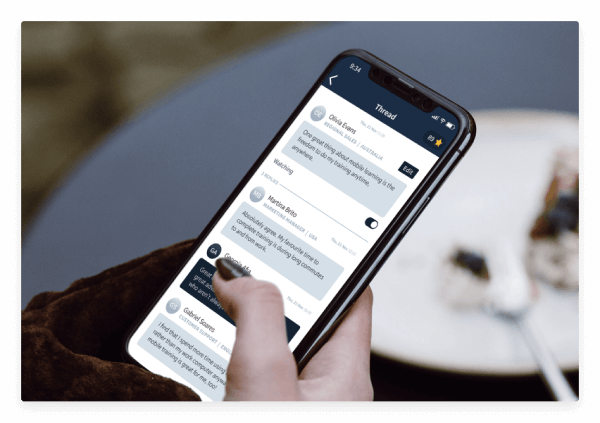
SC Training (formerly EdApp)’s Discussion feature capitalizes on this forum-style exchange and helps learners provide richer contributions through video and image submissions for a more interactive learning experience. As the human brain processes images 60,000 times faster than text and 90 percent of information transmitted to the brain is visual, images and video have higher interaction and retention rates. It also allows learners to have the freedom to express their points in an open-ended format, which strengthens the connection between learners.
8. Gamify your training
Using gamification examples for blended training hooks learners into your training and drives more interest and participation. After all, learning is more effective when it’s fun. It’s an effective way to combat the lack of motivation associated with learning work-related information. Also, a learning-through-gaming model keeps learners interested as it turns boring and mundane tasks into something enjoyable.
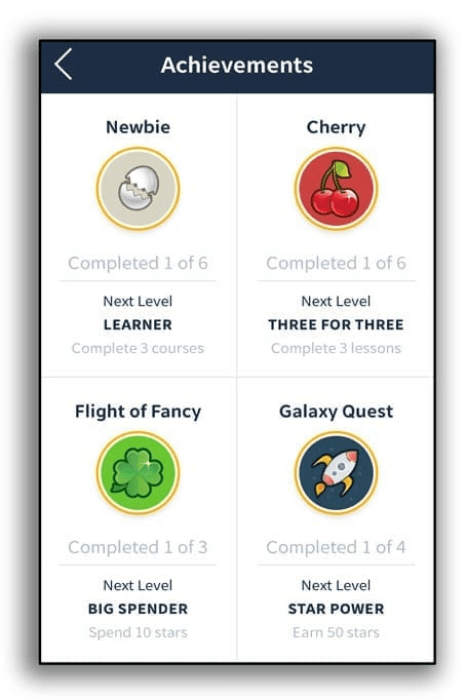
SC Training (formerly EdApp)’s rapid authoring tool includes a selection of free ready-made game templates which works right out of the box. All you need to do is enter your training content and populate it. It includes a jeopardy game (similar to the popular game show of the same name), memory game, and a letter jumble, which makes answering courses a fun learning experience rather than an actual work task. Other game design elements and principles, such as leaderboards, rewards, achievements, and scoring, can be used in the course content to promote user engagement.
9. Track your learners’ progress
If you want to achieve your desired learning outcome, it’s crucial to keep track of your learners’ progress early on so you can adjust and improve training as needed. Once you have these insights, it’s also in your best interest to request feedback from learners so you can figure out and deliver the best learning experience that works from them. This enables you to easily create an agile, impact-driven, and relevant training experience for your teams.
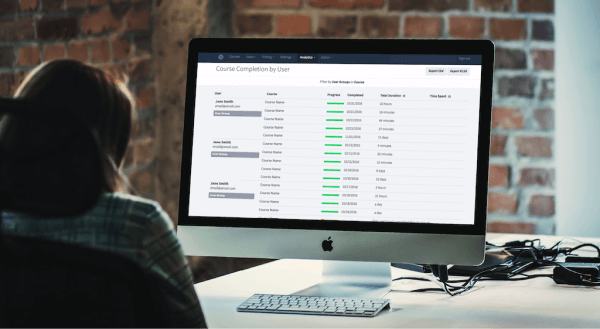
With SC Training (formerly EdApp)’s in-built reporting, you’ll be able to monitor learners, identify knowledge gaps, and even re-engage learners through push notifications and emails. If you want to drill down further, the course analytics feature will allow you to keep tabs on the learner’s experience as they go through each slide.
10. Use online quizzes to check for understanding
Quizzes and assessments are a standard way to check how much was learned in training. It also gauges the effectiveness of your training program. Shifting from traditional to online quizzes in assessing employees makes online test creation faster and more efficient, especially if you use tools, such as online quiz creators. They are also easier to deploy to your remote learners as they can be as simple as a link or included in your courseware.
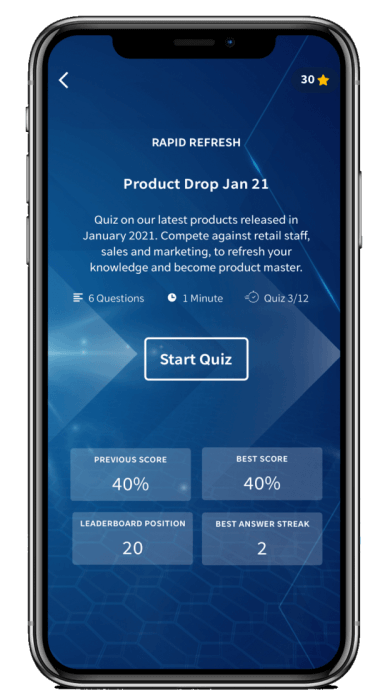
Rapid Refresh is SC Training (formerly EdApp)’s quiz maker that allows you to automatically deliver quizzes at set intervals or in one go to gauge and reinforce learning. All you have to do is fill out the easy-to-complete spreadsheet and a quiz is automatically made for you using SC Training (formerly EdApp)’s intuitive microlearning templates. This also includes granular reporting so you can assess the performance of every learner all the way down to a question level.
You might also be interested in:
Author
Gabrielle Rivera
Gabrielle is an eLearning content writer for SC Training (formerly EdApp), a microlearning solution designed for today's digital habits. She creates content about cutting-edge learning technologies and resources to help companies deliver great training experiences. When not absorbed in writing, she spends her time playing video games and reading books.